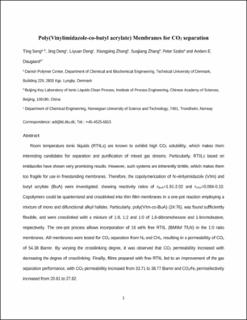| dc.contributor.author | Ting, Song | |
| dc.contributor.author | Deng, Jing | |
| dc.contributor.author | Deng, Liyuan | |
| dc.contributor.author | Bai, Lu | |
| dc.contributor.author | Zhang, Xiangping | |
| dc.contributor.author | Zhang, Suojiang | |
| dc.contributor.author | Szabo, Peter | |
| dc.contributor.author | Daugaard, Anders E. | |
| dc.date.accessioned | 2020-05-18T07:57:11Z | |
| dc.date.available | 2020-05-18T07:57:11Z | |
| dc.date.created | 2018-12-07T15:58:45Z | |
| dc.date.issued | 2019 | |
| dc.identifier.citation | Polymer. 2019, 160 223-230. | en_US |
| dc.identifier.issn | 0032-3861 | |
| dc.identifier.uri | https://hdl.handle.net/11250/2654719 | |
| dc.description.abstract | Room temperature ionic liquids (RTILs) are known to exhibit high CO2 solubility, which makes them interesting candidates for separation and purification of mixed gas streams. Particularly, RTILs based on imidazoles have shown very promising results. However, membranes of the corresponding poly(RT-IL)s are inherently brittle, which makes them too fragile for use in freestanding membranes. Therefore, copolymers of N-vinylimidazole (VIm) and butyl acrylate (BuA) were prepared, showing reactivity ratios of rBuA = 1.91–2.02 and rVIm = 0.094–0.10. The prepared copolymers of poly(VIm-co-BuA) with a copolymer composition of 24:76 had sufficiently low Tg (−6.6 °C) and were flexible enough to be used for membrane preparation. The copolymer was quarternized and crosslinked in a one-pot reaction into thin film membranes employing a mixture of mono and difunctional alkyl halides. Membranes were prepared using a mixture of 1:8, 1:2 and 1:0 of 1,6-dibromohexane and 1-bromobutane, resulting in different degrees of crosslinking. The one-pot process additionally allows incorporation of up to 16 wt% free RTIL (BMIM Tf2N) in the 1:0 ratio membranes. All membranes were tested for CO2 permeability (33.7–54.38 barrer), and for selectivity towards N2 and CH4. By varying the crosslinking degree, it was observed that CO2 permeability increased with decreasing the degree of crosslinking. Finally, films prepared with free RTIL led to an improvement of the gas separation performance, with CO2 permeability increased from 33.71 to 38.77 barrer and CO2/N2 permselectivity increased from 20.81 to 27.82. | en_US |
| dc.language.iso | eng | en_US |
| dc.publisher | Elsevier | en_US |
| dc.rights | Attribution-NonCommercial-NoDerivatives 4.0 Internasjonal | * |
| dc.rights.uri | http://creativecommons.org/licenses/by-nc-nd/4.0/deed.no | * |
| dc.title | Poly(vinylimidazole-co-butyl acrylate) membranes for CO2 separation | en_US |
| dc.type | Peer reviewed | en_US |
| dc.type | Journal article | en_US |
| dc.description.version | acceptedVersion | en_US |
| dc.source.pagenumber | 223-230 | en_US |
| dc.source.volume | 160 | en_US |
| dc.source.journal | Polymer | en_US |
| dc.identifier.doi | 10.1016/j.polymer.2018.11.058 | |
| dc.identifier.cristin | 1640499 | |
| dc.description.localcode | © 2018. This is the authors’ accepted and refereed manuscript to the article. Locked until 27.11.2020 due to copyright restrictions. This manuscript version is made available under the CC-BY-NC-ND 4.0 license http://creativecommons.org/licenses/by-nc-nd/4.0/ " | en_US |
| cristin.unitcode | 194,66,30,0 | |
| cristin.unitname | Institutt for kjemisk prosessteknologi | |
| cristin.ispublished | true | |
| cristin.fulltext | preprint | |
| cristin.qualitycode | 1 | |

